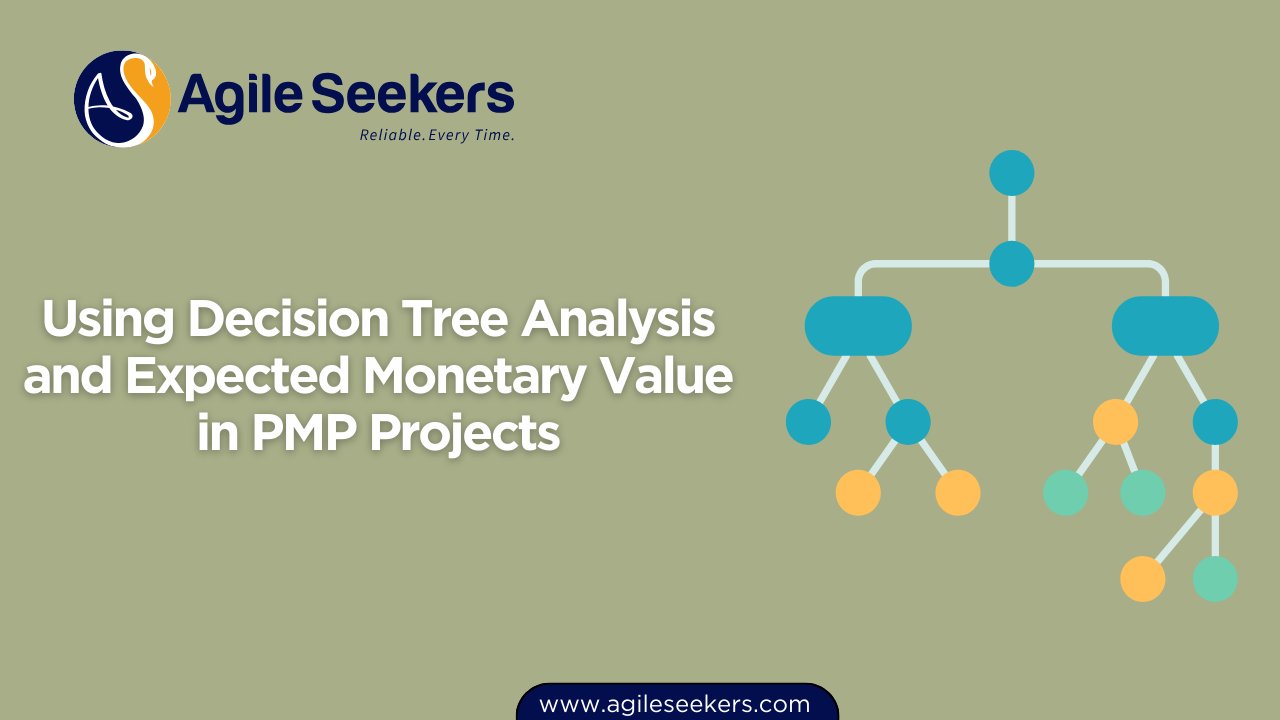Using Decision Tree Analysis and Expected Monetary Value in PMP Projects

Managing project risks effectively is a cornerstone of professional project management. Two powerful tools for risk-based decision-making in PMP projects are Decision Tree Analysis and Expected Monetary Value (EMV). These tools help project managers weigh the financial implications of different risks and outcomes, allowing better, data-informed choices.
This article explores what Decision Tree Analysis and EMV are, how they are used in project management, and how they can strengthen your approach to uncertainty and risk handling in projects.
Decision Tree Analysis is a quantitative risk analysis technique that lays out different decision paths and possible outcomes in a structured, visual format. It uses a branching model where each branch represents a decision or an uncertain event, and each outcome is assigned a probability and value.
For example, a project manager facing two possible vendors—one cheaper but riskier, another more expensive but reliable—can use a decision tree to map out the financial impact and likelihood of success for each choice.
This visual approach helps teams:
-
Clarify complex choices
-
Break down risks into smaller, understandable parts
-
See both the costs and probabilities of outcomes
The Project Management Professional certification emphasizes this kind of quantitative analysis, ensuring that certified professionals can confidently apply structured decision-making techniques.
Expected Monetary Value (EMV) is the key calculation behind Decision Tree Analysis. It is a statistical technique used to determine the average outcome when the future includes uncertainty. EMV helps project managers figure out which choice has the best expected value, factoring in both gains and losses.
The formula is simple:
EMV = Probability × Impact (positive or negative)
For example, if there’s a 40% chance of a $10,000 risk event and a 60% chance it won’t happen, the EMV is:
(0.4 × -$10,000) + (0.6 × $0) = -$4,000
This negative EMV suggests a risk exposure of $4,000, which can then be compared across different scenarios.
For those preparing through PMP training, learning to calculate EMV accurately is essential because it shows up frequently on the PMP exam and in real-world applications.
Let’s break down how these tools come together in practice.
Start by clearly defining the decision point or risk event. For instance, should you outsource part of the work or keep it in-house? Should you add a project buffer, or run with the current schedule?
Map out the possible outcomes for each decision. For outsourcing, outcomes might include:
-
Successful delivery
-
Delivery delay
-
Cost overruns
-
Quality issues
Assign a probability to each outcome. This can be done using historical data, expert judgment, or risk models.
Estimate the cost or benefit associated with each outcome. This includes both direct costs (extra materials, overtime) and indirect costs (loss of reputation, stakeholder dissatisfaction).
Multiply the probability of each outcome by its monetary value to calculate the EMV.
Draw the decision tree with branches for each decision and outcome. Include the EMV calculations at the end of each branch.
Sum up the EMV values for each decision path. The option with the highest EMV (or least negative) is usually the preferred path.
Here’s a simple example.
You are managing a software project and must decide whether to:
-
Hire an external testing team (Option A)
-
Keep testing in-house (Option B)
| Option | Outcome | Probability | Monetary Impact | EMV |
|---|---|---|---|---|
| External Team (A) | On-time, on-budget | 0.7 | $0 | $0 |
| Delay, extra cost | 0.3 | -$10,000 | - $3,000 | |
| In-House (B) | On-time, on-budget | 0.5 | $0 | $0 |
| Delay, extra cost | 0.5 | -$5,000 | - $2,500 |
EMV for Option A: -$3,000
EMV for Option B: -$2,500
Despite the in-house team having a lower risk profile, it carries a smaller expected loss. Based on EMV, Option B might be the safer financial choice.
There are several advantages to using these tools in project management:
-
Data-driven decisions: You move beyond gut feeling to structured, financial comparisons.
-
Clear visual representation: Decision trees provide clarity, especially when explaining options to stakeholders.
-
Better risk awareness: Quantifying risks helps prioritize management efforts.
-
Supports PMP exam preparation: Familiarity with these tools is crucial for those working toward PMP Certification.
If you’re enrolled in PMP certification training, you’ll encounter exercises and scenarios where you’ll apply these methods directly. You can learn more about how these techniques integrate with broader project management practices on the PMP training page.
While useful, these techniques aren’t without challenges:
-
Estimating probabilities: Assigning accurate probabilities is hard, especially when lacking historical data.
-
Assessing monetary impacts: Not all impacts are easily quantifiable.
-
Complexity: For projects with many variables, decision trees can become unwieldy.
To manage these challenges:
-
Use expert judgment and lessons learned from past projects.
-
Conduct sensitivity analysis to see how changes in probabilities or costs affect the outcome.
-
Focus on the most critical decisions and risks first, avoiding overcomplication.
To deepen your understanding, consider exploring:
-
PMI’s official resources on quantitative risk analysis.
-
Case studies on decision tree analysis in project management from academic publications or professional journals.
-
Tools like Monte Carlo simulations, which extend EMV concepts into broader risk modeling.
Decision Tree Analysis and Expected Monetary Value are indispensable tools for project managers seeking to make informed, risk-based decisions. They allow you to visualize decision paths, quantify financial outcomes, and select the best course of action under uncertainty.
If you’re preparing for the Project Management Professional certification, make sure to practice applying these tools in mock scenarios and real project settings. This strengthens both your exam readiness and your practical project management skills.
For more on building your risk management expertise, check out PMP certification programs, which cover quantitative and qualitative risk techniques in depth.
Also read - Sensitivity Analysis for Project Risk Assessment




















